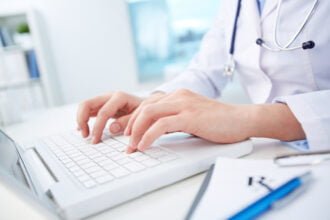 This is the transcript of my recent podcast with EarlySense’s president, Tim O’Malley.
This is the transcript of my recent podcast with EarlySense’s president, Tim O’Malley.
 This is the transcript of my recent podcast with EarlySense’s president, Tim O’Malley.
This is the transcript of my recent podcast with EarlySense’s president, Tim O’Malley.
David E. Williams: This is David Williams, president of Health Business Group. I’m speaking with Tim O’Malley, president of EarlySense.
Tim, thanks for joining me today.
Tim O’Malley: Thanks, David, for having me on.
Williams: Tim, can you explain, what is EarlySense? What does the company do in general?
O’Malley: For many years, healthcare providers have tried to find a way to monitor patients in almost all locations of the hospital and even in some subacute care and skilled nursing facilities, to make sure that patients were being served appropriately. So that if there was any sign of deterioration, if there was any sign of physical instability of the patient, they would have a way of capturing these things and giving them early warning that something potentially could be occurring, that could be an adverse event.
And so what we’ve done is developed a sensor that’s placed under the mattress of the patient to monitor the patient’s heart rate, respiratory rate and body motion so that we can help the caregivers avert adverse events, whether it be deterioration or falls and/or pressure ulcers that occur in healthcare settings.
Williams: So, as you mentioned, a lot of people have tried to do this in the past. I know there are various challenges in making it happen. It sounds like what you do is put the sensor under the mattress or the pad instead of on the patient. All else being equal, I would imagine that would maybe be less reliable to use. So, why did you take that approach and does it actually work?
O’Malley: I wouldn’t say it’s less reliable. I think it’s actually more reliable because signals from a traditional product that might be used in deterioration-monitoring would be an EKG lead. Anybody that has been in a hospital or healthcare setting that has seen an EKG lead set. It could be three-lead, it could be five-lead and in some cardiologist settings, it could be 12 leads where they paste electrodes onto the skin. And those are the source of the signals –electrical signals that are then interpreted by the traditional patient-monitoring product.
And there’s clearly still a very big need for that in the high-acuity areas. But when you take that technology and you push it out to the lower-acuity areas, you have the potential for a lot of problems. And problems like alarm fatigue have become a very real concern for the caregivers because you have so many alarms that are generated from this traditional monitoring system because of design for an ICU or acuity care environment. When you put them into an area that has a staff to patient ratio of 1:4 or 1:6 instead of an ICU with a staff ratio of 1:1 or 1:2, you now have the staff spending an awful lot of time trying to manage alarms and manage the technology and not as much time of potentially managing the patients.
So, when you eliminate those leads and sensors out of the patient, you also eliminate a lot of those problems. We have validation studies that compare our technology to the more traditional methods where you actually had sensors on the patient. The accuracy has been within a few percentage points.
And so it is very accurate, it is very proven. We were in about a dozen and a half hospitals in the United States and every day, there’s probably close to a thousand beds that are being used with our technology.
Williams: Say more about alarm fatigue. What is it and how does EarlySense contribute to reducing alarm fatigue? It sounds like this is a key benefit.
O’Malley: It is indeed one of our benefits. Here again, it’s a tough situation in healthcare. You have a sicker and sicker patient population because the patient population is aging. You have patients that are having procedures much later in life that are somewhat complex. You have patients that are in their golden years having repeated procedures that are pretty significant procedures; those patients will end up post-operatively, maybe 24 hours post-operatively in the med/surg or general care environment.
And they may have comorbidities where they’re having respiratory issues or challenges. They may have some underlying cardiac problems. They may have diabetic issues. So those patients now have many more comorbidities than just a few years ago.
So, having a piece of technology that you could put at every bed in a convenient way and be able to monitor in a way that is designed for that environment, seems to be a much better way to go. And traditional technology is designed, as I’ve said, for a higher acuity environment, which has a 1:1 ratio of staff to patient.
Alarms are really a kind of traditional threshold alarm. You hit the threshold, you go over that threshold or under that threshold, you’ll get an alarm. With our system, it uses an algorithm to look at the past record of cardiac or respiratory activity and then will actually add those things over that time so that the alarm rate is dramatically reduced. In the med/surg environment, patients are moving, they’re talking, they’re eating or interacting with family. And so, all those things have an impact on a traditional product’s capability to monitor and alarm effectively. And as a result, there’s an awful lot of nuisance alarms and false alarms.
Just recently ECRI and The Joint Commission came out with indicators encouraging caregivers to really watch this phenomena of alarm fatigue, because what happens is that the staff is just bombarded with alarms. Over time, they become desensitized to those alarms. And that’s, unfortunately, an adverse event that’s starting to occur. That’s when a negative situation can develop.
Williams: Talk about how the changes in healthcare affect what EarlySense is doing. I’m assuming that your discussions about return-on-investment and use cases are influenced by what’s going on in the market. Can you talk a little bit about that please?
O’Malley: It’s an interesting time in healthcare for a lot of reasons. I’ve been in the industry for over 25 years now and I have seen a lot of change, a lot of very positive technological change that has improved patient care. Now healthcare is going to be forced to manage itself much more as a business and that means controlling costs
and managing the revenue streams so that they can maintain their margins. But the reality is that, in the last few years, there has been a dramatic squeeze on healthcare systems’ margins. In the new environment healthcare systems are looking for true tools to help.
Today, because of the downward pressure on margins and the move to capitation, administrators are being much more diligent in how they evaluate potential purchases. They’re not just looking at the clinical benefit, they’re also looking for economic benefit. Economic benefit could be things like how do you eliminate alarm fatigue in an environment to improve patient care? Or in the case of medical sciences, how do you take a piece of technology and put it into a general environment, like a med/surg environment, to potentially detect deterioration of a patient who otherwise wouldn’t be monitored.
Williams: With the Affordable Care Act, are there specific changes, for example, in hospital penalties for readmissions that affect the way customers think about EarlySense and affect the way that you go to market or develop products?
O’Malley: Yes. We have a customer that’s been using our technology for about two years. And just a few weeks ago, I met with their C-level people and we reviewed the effects of EarlySense in their care area: 36 beds that had been monitored on an ongoing basis.
We looked at the data. We looked at the number of falls and the number of pressure ulcers during all of 2012. And then we compared that to the areas of the hospital that are not using EarlySense and what their pressure ulcer and fall rates were.
It became very obvious that the amount of improvement on the EarlySense side of the hospital was dramatic. In fact, no falls and just a few pressure ulcers – and it was questionable whether or not they actually started before the patients were admitted — compared to the other side of the hospital that had double-digit rates of falls, double-digit pressure ulcer rates.
So then the discussion became, how do we help you get this technology to the rest of the hospital so that you can benefit from it across all the beds? Hospitals are looking at the cost of care for those particular events — pressure ulcers and falls. The beds that were monitored by EarlySense were within the $700 per patient range; the cost of care for the non-EarlySense beds was in the $15,000 range.
Hospitals are looking at these things much, much deeper in that regard. They’re looking at technology like ours that can help drive improvement, to potentially drive different numbers for them.
Williams: How does your business model work? Do you charge on a per bed basis or per day or per patient or based on outcomes.
O’Malley: It’s really quite flexible. We did an economic return on investment with a customer and sat down to review it. The resulting proposal was more of a pay-per-day-per-patient kind of proposal, which is more of the service model.
It can be a variety of different ways that people purchase it. In some cases, we really think we’re going to a revenue sharing model with institutions where we will put some guarantee in place to impact things like fall rates by X percent. And if we don’t meet those guarantees, then there are financial consequences.
Williams: Tim, Governor Deval Patrick traveled from Massachusetts to Israel back in 2011 on a trade mission and one of the tangible outcomes of that was that EarlySense decided to move its headquarters and locate in the US, in Massachusetts. It’s a couple of years or so since that occurred. And I’m wondering, what is the perspective from EarlySense on how that has worked out?
O’Malley: Massachusetts is a very rich environment with med-tech talent. There’s a lot of med-tech companies in Massachusetts. When you are a growing company like EarlySense, you have to look for people to come in to help you build out different parts of the organization. We’re clearly doing that. And so, we’ve been able to attract very talented people in Massachusetts because it’s such a rich environment for med-tech professionals.
In addition, we have also developed some pretty significant customer relationships in Massachusetts with a number of the Partners HealthCare facilities. And that exposure that we gained by Governor Patrick going to Israel and subsequently performing a ribbon-cutting ceremony with us in MetroWest Medical Center, I think certainly helps us gain exposure and credibility.
Williams: This is David Williams with the Health Business Group. I’ve been speaking with Tim O’Malley. He’s the president of EarlySense. Tim, thanks so much for your time today.
O’Malley: Thanks for having us on, David. I appreciate the opportunity to talk about our technology and how we’re able to help healthcare providers avoid adverse events.
(Image via EarlySense)








